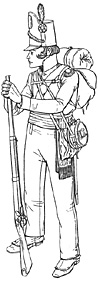 This was a gripping, entertaining game. At every turn, Boerstler (me) had a new tactical problem to solve with only a minimum understanding of the real situation. Of course, that’s the fun of solo gaming – confronting a military problem which is evolving in ways that are the result of chance rather than a predictable operation generated by a human opponent.
This was a gripping, entertaining game. At every turn, Boerstler (me) had a new tactical problem to solve with only a minimum understanding of the real situation. Of course, that’s the fun of solo gaming – confronting a military problem which is evolving in ways that are the result of chance rather than a predictable operation generated by a human opponent.
In this game, the quicker the Americans could move across the board, the less opposition they would likely see. Because there was a one-third chance each turn that a British unit would enter the battlefield, the fewer turns in the game translates into less opposition. Therefore it behooved the American player not to waste time in elegant maneuvers but to resolve problems “down and dirty.” This dynamic was faithful to my scenario as well. The longer it takes to respond to a problem, the more likely it is that the problem will only grow in scope and severity. This is unlike typical games in which all forces are on the board at the start of the game and both sides have a perfect understanding of what they are confronting.
The other innovation, for me at least, was to maneuver companies rather than whole battalions. Each company was unique either in strength or quality. I had to use my strong companies judiciously because, as I learned, bad things happen when a weak company fails. But even weak companies had their contribution to make (usually in defensive firepower) if the leader or a stronger unit was close by.
The other advantage of this game in particular is that there were many more unit “types” that I could use that would be appropriate to the scenario. For example, on the American side I could have added rifle companies, both regular and militia, as well as a company of dragoons, again either regulars or volunteer militia. On the British side, I could have used flank companies with special qualities. The Canadians might have included “coureurs de bois”, voltigeurs, or select militia (fairly well trained flank companies).
I can not recommend Our Moccasins Trickled Blood highly enough as an appropriate rule set for woodland combat between small yet diverse opponents (the figures, not the wargamers). There is significant room for chance and a role for leadership and training. The games I play always have interesting turns and results. But now, on to my next War of 1812 project, a siege of a stockade fortification.
Twelve Mile Creek A Wargame Scenario
Back to Table of Contents -- Lone Warrior 150
Back to Lone Warrior List of Issues
Back to MagWeb Magazine List
© Copyright 2005 by SWA.
This article appears in MagWeb.com (Magazine Web) on the Internet World Wide Web.
Other articles from military history and related magazines are available at http://www.magweb.com
